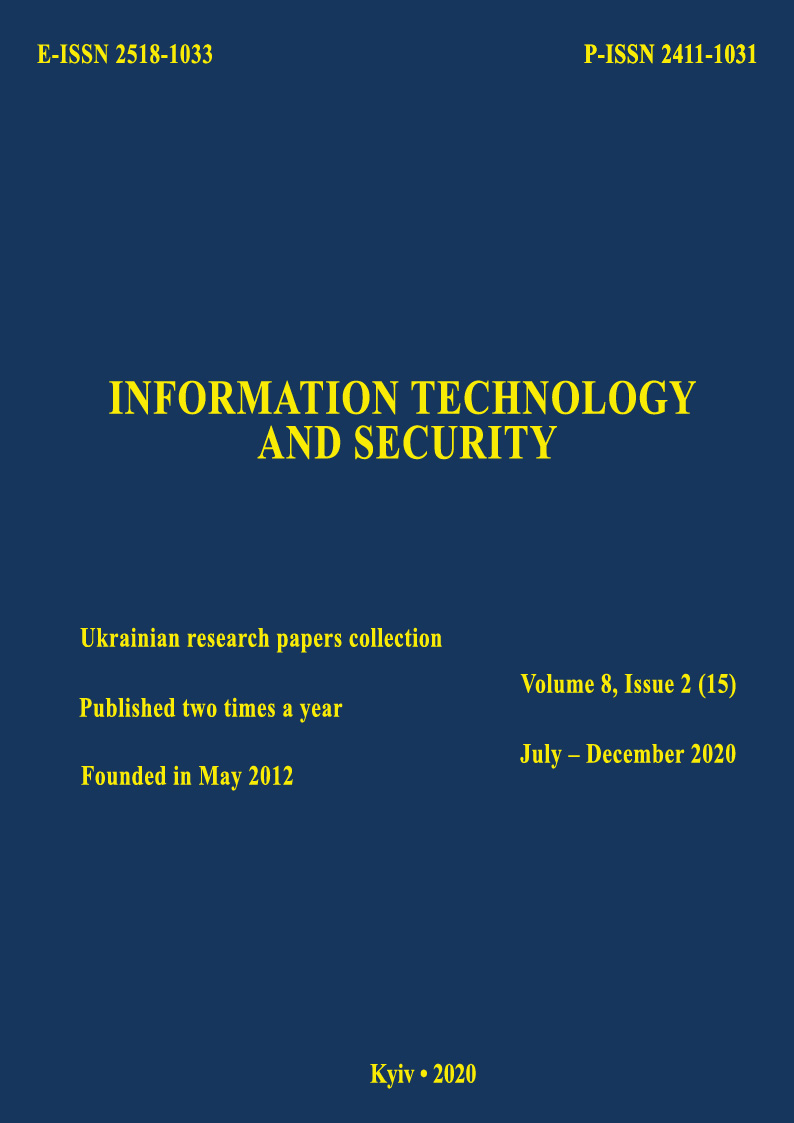Influence of destabilizing factors on the stability of user's handwritten signature indicators
DOI:
https://doi.org/10.20535/2411-1031.2020.8.2.222592Keywords:
authentication, biometric user authentication, biometric characteristics, biometric vector, handwritten signature, biometric authentication systemAbstract
Consideration is given to the question of user`s handwritten signature parameters informativeness and stability during authentication. An identifier that uses biometric characteristics is inextricably linked to the user and it is almost impossible to use it without authorization. It is proposed to use dynamic biometric characteristics of users. Their advantage is that due to the presence of a dynamic component, the probability of their forgery by an attacker is very low. A handwritten signature is used as a biometric characteristic of the user. A handwritten signature is a socially and legally recognized biometric characteristic used for human authentication. It has a rather complex structure and high detail - all this makes solving the problem of user identification by mathematical methods quite complex and requires high computational costs. Another significant disadvantage is that handwritten authentication systems require the installation of additional specialized equipment, which makes the use of such systems as an ordinary means of authentication very expensive. Nowadays the presence of mobile devices in almost all users has made it possible to form the idea of using them in authentication systems. Thanks to that a scheme for implementing a computer security system against unauthorized access based on handwritten signatures using Android-based mobile devices as signature input devices were proposed. An algorithm based on Heming's distance was chosen to implement user tolerance. According to the selected algorithm, a method for forming a biometric vector has been developed. The optimal characteristics are investigated and the efficiency of using the proposed form biometric characteristics vector is estimated. The speed of movement at certain intervals and the inclination angle of the vector interval were chosen as indicators of the handwritten signature. It is offered to estimate stability in time and dependence of the chosen biometric signs on the following factors: emotional and physical condition of the user, and also time of day at the moment of authentication. Developed a software application for the Android operating system, which collects the time characteristics and values of the proposed factors for time characteristics vectors, as well as allows to export the accumulated data.
References
E. Anisimova, “About the verification problem using handwritten signatures”, Modern technology and technology, no. 3, 2016. [Online]. Available: http://technology.snauka.ru/2016/03/9715. Accessed on: July 15, 2020.
A. Skorodumov, “Pros and cons of biometric identification”, Information Security, no. 6, pp. 31-33, 2018. [Online]. Available: http://lib.itsec.ru/articles2. Accessed on: July 20, 2020.
I. Horniichuk, and V. Yevetskiy, “Use of keyboard handwriting in user authentication systems”, Information Technology and Security, vol. 4, iss. 1, pp. 27-33, 2016, doi: https://doi.org/10.20535/2411-1031.2016.4.1.95927.
L. Irwin, “GDPR: Things to consider when processing biometric data”, IT Governance European Blog, 2017. [Online]. Available: https://www.itgovernance.eu/blog/en/gdpr-things-to-consider-when-processing-biometric-data. Accessed on: June 12, 2020.
I. Smirnov, and S. Borisov, “Handwriting recognition when authenticating PC users”, Succeeding in modern natural science, no. 6, pp. 99-100, 2012.
Y. Zheludov, “Identification problems in handwritten recognition systems”, Scientific journal “Informatics”, no. 9 (32), 2018. [Online]. Available: https://cyberleninka.ru/article/n/problemy-identifikatsii-v-sistemah-raspoznavaniya-rukopisnyh-podpisey. Accessed on: June 20, 2020.
I. Horniichuk, V. Yevetskiy, and V. Kubrak, “Applying mobile devices in biometric user authentication systems”, Information Technology and Security, vol. 7, iss. 1, pp. 14-24, 2019, doi: https://doi.org/10.20535/2411-1031.2019.7.1.184213.
I. Horniichuk, and V. Yevetskiy, “Selection of handwritten signature dynamic indicators for user authentication”, Information Technology and Security, vol. 8, iss. 1, pp. 19-30, 2020, doi: https://doi.org/10.20535/2411-1031.2020.8.1.217994.
SignToLogin – Products. Signtologin.com, 2020. [Online]. Available: https://signtologin.com/products. Accessed on: Aug. 01, 2020.
DocuSign eSignature. DocuSign Inc., 2020. [Online]. Available: https://www.docusign.com/products/electronic-signature. Accessed on: Aug. 01, 2020.
M™ Electronic Signature Authentication (ESA) Software. 3M.com, 2020. [Online]. Available: https://www.3m.com/3M/en_US/company-us/all-3m-products/~/3M-Electronic-Signature-Authentication-ESA-Software/?N=5002385+3290603306&rt=rud. Accessed on: Aug. 01, 2020.
Wacom Inc. technology for Developers. Wacom Inc., 2020. [Online]. Available: https://developer.wacom.com/en-us. Accessed on: Aug. 01, 2020.
Solutions: HUION. Shenzhen Huion Animation Technology Co., 2020. [Online]. Available: https://support.huion.com/support/solutions. Accessed on: Aug. 01, 2020.
Download Developer Tools (API/SDK). Signotec GmbH, 2020. [Online]. Available: https://en.signotec.com/service/downloads/developer-tools-api-sdk-/. Accessed on: Aug. 01, 2020.
I. Anikin, and E. Anisimova, “Detection of dynamic handwritten signature based on fuzzy logic”, Bulletin of the Kazan State Energy University, no. 3 (31), pp. 48-64, 2016.
V. Lipsky, “Identification of handwritten signatures using neural networks”, in Proc. 54-th scientific conference of post-graduate students, masters and students of BSUIR, Minsk, 2018, pp. 84-85.
A. Karelin, Great encyclopedia of psychological tests. Moscow, Russia: EKSMO, 2005.
Firebase by platform. Firebase, 2020. [Online]. Available: https://firebase.google.com/docs. Accessed on: July. 01, 2020.
Downloads
Published
How to Cite
Issue
Section
License
Copyright (c) 2020 Information Technology and Security

This work is licensed under a Creative Commons Attribution 4.0 International License.
The authors that are published in this collection, agree to the following terms:
- The authors reserve the right to authorship of their work and pass the collection right of first publication this work is licensed under the Creative Commons Attribution License, which allows others to freely distribute the published work with the obligatory reference to the authors of the original work and the first publication of the work in this collection.
- The authors have the right to conclude an agreement on exclusive distribution of the work in the form in which it was published this anthology (for example, to place the work in a digital repository institution or to publish in the structure of the monograph), provided that references to the first publication of the work in this collection.
- Policy of the journal allows and encourages the placement of authors on the Internet (for example, in storage facilities or on personal web sites) the manuscript of the work, prior to the submission of the manuscript to the editor, and during its editorial processing, as it contributes to productive scientific discussion and positive effect on the efficiency and dynamics of citations of published work (see The Effect of Open Access).

